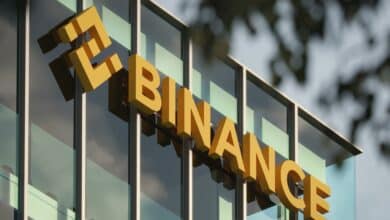What Is A Chainlink VRF?

Smart contracts can handle data points while maintaining security and usability by employing the provably fair and verifiable random number generator (RNG) offered by Chainlink VRF. In recent years, blockchain technology has revolutionized the way we do business, leading to a wide range of innovative applications.
Blockchain technology has several promising utilities, and cryptocurrencies are just one of them. This ground-breaking technology can also be used in a wide range of other fields. The development of safe, decentralized markets in the digital world has been made easier by the use of blockchain technology.
This new innovation is a great addition to the smart contract functionality that is famous among Ethereum-based platforms, offering substantially more credibility since all of the transactions are intrinsically stored on blockchain. By enabling new business models, decentralized apps (DApps) are profoundly changing traditional sectors like consumer banking and enabling use cases that were previously unimaginable.
These blockchain-based applications, like Ethereum, are revolutionizing every aspect of our lives, from governance to finance.
Smart contracts are strengthened by the blockchain oracle technology, which connects them to actual statistics, activities, and money transfers that play a role in interacting with the off-chain community and incorporating data that comes into DApps on the Ethereum blockchain.
The variety of practical systems that blockchain networks can provide has now grown to include a variety of third-party solutions, including outbound, inbound, hardware, and software oracles. Peer-to-peer decentralization is a requirement for protecting the entire blockchain network in which oracle systems based on consensus such as the Chainlink protocol work.
The oracles provide a more secure and reliable platform for smart contracts in comparison to on-chain networks. They are easy to use, compatible with other systems, and efficient.
By using hybridized smart contracts that combine the best features of blockchains with the power and flexibility of oracle networks, users will be able to make this transition much more easily and effectively than if they relied only on on-chain systems.
The Chainlink VRF: What does it do?
Numerous DApps in the nonfungible token (NFT) and blockchain gaming industry necessitate a based intrusion detection system and substantiated originator for randomly generated numbers for the purpose of providing sophisticated features like successfully implementing an airdrop, having to run a lottery, or generating big possibility games.
The verifiable random function (VRF) by Chainlink tends to rely on a decentralized oracle network (DON) to leverage existing blockchain applications by supplying authenticated off-chain statistics. It is a cryptographic algorithm that allows users to verify the randomness of data. This verification enables users to trust the data as being truly random.
Chainlink’s VRF is a cryptographic primitive that enables a secure, tamper-proof connection between two parties. Its foundation is a random function, which makes reversing it computationally prohibitive. It may even enable the importation of blockchain ledger to frameworks outside the cryptocurrency industry. This makes it a valuable tool for expanding the potential applications of blockchain technology.
Chainlink VRF delivers blockchain-based randomization by leveraging a number of nodes of Chainlink that transport information to smart contracts with preserving a traditional process with the assistance of a panel of such nodes. This provides cryptographically secured randomness.
With Chainlink VRF, developers can effectively use spontaneous results in their blockchain technologies by generating random numbers for smart contracts. This helps create more interesting and engaging experiences for users.
Chainlink VRF provides an extremely secure method of generating random numbers since each oracle is protected by its own private key and the numbers generated by each oracle are completely random. Furthermore, since the keys to these oracles are kept off-chain, no node operator can tamper with them.
Chainlink VRF is an innovative way to create secure networks without relying on centralized servers. It works by using a mesh network of nodes to route traffic. This makes it incredibly resistant to attacks, and it can be used to connect homes, businesses, and other areas of a network.
Chainlink VRF works by using a network of decentralized nodes to create a mesh network that can process large amounts of data. This network is resistant to attack and can be used to create a variety of applications.
Every request made by Chainlink VRF is accompanied by a cryptographic algorithm that demonstrates how the requested value was generated. Before being used by any leveraging application, the proof is broadcasted and validated on the blockchain. By using this procedure, it is ensured that no one party, such as miners, users, oracle operators, or smart contract authors, may meddle with or influence the outcomes.
This can be used to create contracts that are more secure and efficient, making them more likely to be fulfilled. Additionally, Chainlink can be used to create decentralized applications that are immune to censorship and hacking. For almost any system that depends on erratic results, Chainlink is a ledger platform that has the ability to build trustworthy smart contracts.
With Chainlink, you can create non-fungible tokens (NFTs) or blockchain-based games. This opens up a range of new possibilities for gaming and asset management and allows for a secure and tamper-proof platform for trading and exchanging virtual assets.
In a Chainlink network, each node is assigned a random set of duties and materials. This allows the network to function more efficiently and effectively. For instance, randomly assigning judges to cases can help ensure fairness and impartiality in judicial proceedings. This method can help to ensure that all parties have an equal opportunity to be heard and that each case is judged based on its own merits.
Chainlink is a network-based consensus mechanism. Specifically, it uses a network of nodes to reach an agreement about what to do. Each node in the chainlink network is responsible for verifying the validity of the next node in the chain. This approach is carried out again until the entire network agrees on what should be done.
Chainlink VRF’s working
Because of the systematic nature of computers, randomization is a significant but complex experience when working with them. This is particularly relevant when referring to distributed ledger technology since the computer is not only predictable but also observable. As a result, Solidity’s native generation of verified random numbers is not possible.
If every node generated its individual random number, they will not know which random number to employ when they try to come to an agreement. Chainlink VRF is the way to solve this issue, allowing us to generate a provably random value while also having the credibility of that randomness convincingly validated on the ledger.
Using Chainlink VRF, a smart contract can obtain a random number that is reliable and verified in only four steps.
- Make and finance a membership on the main Ethereum network or a testnet like Kovan, Rinkeby, or Ropsten.
- Make a smart contract that is compatible with chainlink VRF and publish it on the Ethereum mainnet or a testnet.
- Utilize the smart contract that has been implemented to demand random values, and save the oracle’s output as something of an arrangement in the smart contract.
- Authentication can be carried out to confirm the random number generation procedure using the public key of the database and a secret key native to the contract.
For applications capable of extended computation, Chainlink VRF provides a significantly reliable and decentralized holding of personal keys by creating a random but unexpected result using two keys that may be validated by proof of accuracy.
With on-chain encrypted verification, VRF by Chainlink’s on-chain block information is merged as that of an input to provide impartial & tamper-proof outputs that are protected even from corrupted oracles within its own system, eliminating the shortcomings of vulnerable RNG alternatives that depend on off-chain computations.
The Chainlink RNG solvent is an essential tool for the development of decentralized finance applications, like PoolTogether and Moonbeam. Thanks to its reliable functionality, Chainlink VRF usage in this space is becoming increasingly popular.
By providing verified randomized solutions, for instance, Axie Infinity is adding an unpredictable element to on-chain gameplay, while also helping to distribute nonfungible tokens (NFTs), like in the scenario of Polychain Monsters (AXS).
Chainlink VRF provides the necessary infrastructure for smart contracts to carry out complex functions. The guideline provides developers with a reliable way to create apps that are safe and compliant with industry standards. It also helps ensure that apps are consistent and reliable.
Chainlink is constantly working to improve the functionality of its decentralized oracle networks, and it has recently released Chainlink VRF v2, that includes updated methods for acquiring randomization for building smart contracts. This makes it easier for developers to get the randomness they need to create safe and secure contracts.
Per on-chain activity, this system has the capacity to provide a sizable number of random results, lowering costs or response times while potentially accelerating transactions.
Another feature is the ability to request funds for provable randomization from a maximum of one hundred addresses of smart contracts by utilizing a single Network membership balance account, that will be controlled by the membership developer or owner.
With the help of Chainlink VRF v2, developers can pre-fund randomization claims by only using one reference currency balance, doing away with the necessity to deposit funds on every claim. Due to this, Chainlink VRF v2 is significantly more affordable than conventional VRF systems.
The callback query mechanism provides more flexibility and control for smart contract applications, allowing them to change their callback fuel limit whenever they acquire validated randomization.
Although the gas limitations for VRF contracts are larger than those established for Chainlink VRF contracts, they are dependent on the fundamental blockchain and are made explicit on the VRF Contract location’s webpage.
Developers can set the minimum number of node approvals expected in Chainlink VRF v2 until a random number is issued and added to the blockchain. The platform is strengthened and made more effective by the extra flexibility. This makes it easier for developers to create applications that are secure and reliable.
Developers have a variety of options for how many block rounds they would like to have before randomness is produced, with blocks ranging from 3 to 200. This gives them the security they need while still providing a fast response time to inquiries.
Developers now have the ability to use extensible, gas-efficient, and configurable on-chain randomization, which can clearly generate new possibilities for Non-fungible tokens, decentralized apps, and the gaming industry. This could lead to more secure and efficient transactions, and make gaming more enjoyable for both consumers and developers.
The application of VRF, which Chainlink has continued to upgrade, is currently the tool of choice for many developers creating Decentralized applications on the platform of Ethereum. This is a result of Chainlink’s ongoing platform improvement initiatives.
By letting developers design more promising uses that can stably interact with genuine data, Chainlink VRF is fulfilling its commitment to making it smoother to deploy blockchain-based alternatives that can be verified to be reliable. This makes it easier to deploy blockchain-based alternatives that can improve security and reliability.
Chainlink’s VRF technology is a major breakthrough in blockchain technology, enabling developers to stretch the limits of the existing Metaverse beyond what is possible with traditional blockchain platforms. This allows for greater trust and communication with external data streams, making Chainlink a powerful tool in the development of blockchain technology.
Subscription
Subscription accounts provide financing for VRF v2 proposals. By setting up an account and paying in advance for VRF v2, you can avoid having to provide money every time your app seeks randomization. Due to this, using VRF v2 requires less gas overall.
Additionally, it gives you an easy way to pay for your consumption of Chainlink goods from a single spot, saving you from the hassle of managing various wallets among numerous different apps and platforms.
The following fundamental ideas apply to subscriptions:
- ID for Subscription: A 64-bit arbitrary integer serving as the subscription’s individual identifier.
- Accounts for Subscription: Accounts used for subscriptions are those that store LINK tokens and offer them to coordinators of the Chainlink VRF v2 for use in financial planning.
- Owner of Subscription: The wallet account that establishes and maintains a subscription profile is the Every account that has the ability to contribute Funds to the subscription amount, however, only the owner has the ability to add authorized users or withdraw money.
- Consumers: Contracts for which the usage of funds through one’s subscription account has been authorized.
- Balance for Subscription: This demonstrates how much LINK is kept in one’s subscription account. Until the amount is exhausted, claims from consumer contracts will be financed. As a result, make sure you have enough money in your subscription account to cover the requests and maintain your app functioning.
A summary of Chainlink VRF advantages
- With Chainlink VRF, you can use provably randomized, untampered, and inexpensive randomization for smart contracts to boost the user experience of your blockchain-based projects.
- By assuring fair and credible results that can be verified using digital proofs, you can offer your clients a more reliable experience and boost the number of people using your blockchain-based service.
- To safeguard your contract, utilize traceable and provably fair randomization that is impervious to manipulation by consumers, node operators, or hostile actors.
- Chainlink VRF is a market VRF technology that is recognized by leading projects. It has been chosen as the randomness source for countless transactions by dozens of hugely powerful projects, spanning from NFTs to entertainment and even beyond.
- It gives players exposure to independently audited proof that the NFT holdings belonging to them were generated and granted by employing tamper-proof randomization by distributing uncommon non-fungible tokens (NFTs) and granting NFTs some randomized attributes.
- In the blockchain gaming system, use random results to make quality games. It is now possible to use VRF for map generation, crucial strikes (in combat games), random matchmaking (in multiplayer mode), cards pick sequences, and unpredictable interactions.
- Allocate highly sought-after things like tickets to sporting events, choose participants in a well-attended sale to the public, and pick winners of presale prizes like priceless shoes.
- Leverage randomness to decide results in game modes and other circumstances to create vast experiences that are tough and surprising, and to strike the ideal balance between tactics and enjoyment.
- For developers to incorporate randomness into on-chain gameplay and NFT events and enable them to make play-to-earn games that are reasonable and fraud-proof, provable randomization options, such as Chainlink VRF v2, are crucial.
- While granting customers of different addresses accessibility to the balance of subscription, Chainlink VRF delivers reduced gas prices with its subscription management application.
- Oracles that are malevolent or corrupted could provide inaccurate information to your contract if there is no on-chain cryptography verification. Every random number is produced using on-chain block information as an input, demonstrating that it was produced correctly and for the concerned person.
Conclusion
Developers could indeed create trustable smart contracts employing Chainlink VRF for a variety of applications that call for unpredictable results, and during the process complete a broad range of pseudo-random tasks like improving the credibility of games or selecting a fair representation of participants capable of voting on a proposed plan the contract must achieve consensus on.
As several significant projects now employ Chainlink VRF, it appears that this is just the start of the many potential applications for this crucial technology that might continue to support the expansion of the Chainlink industry in general.
Tokenhell produces content exposure for over 5,000 crypto companies and you can be one of them too! Contact at info@tokenhell.com if you have any questions. Cryptocurrencies are highly volatile, conduct your own research before making any investment decisions. Some of the posts on this website are guest posts or paid posts that are not written by Tokenhell authors (namely Crypto Cable , Sponsored Articles and Press Release content) and the views expressed in these types of posts do not reflect the views of this website. Tokenhell is not responsible for the content, accuracy, quality, advertising, products or any other content or banners (ad space) posted on the site. Read full terms and conditions / disclaimer.







